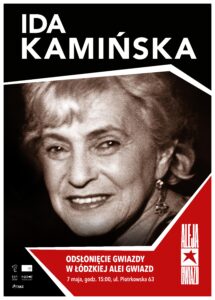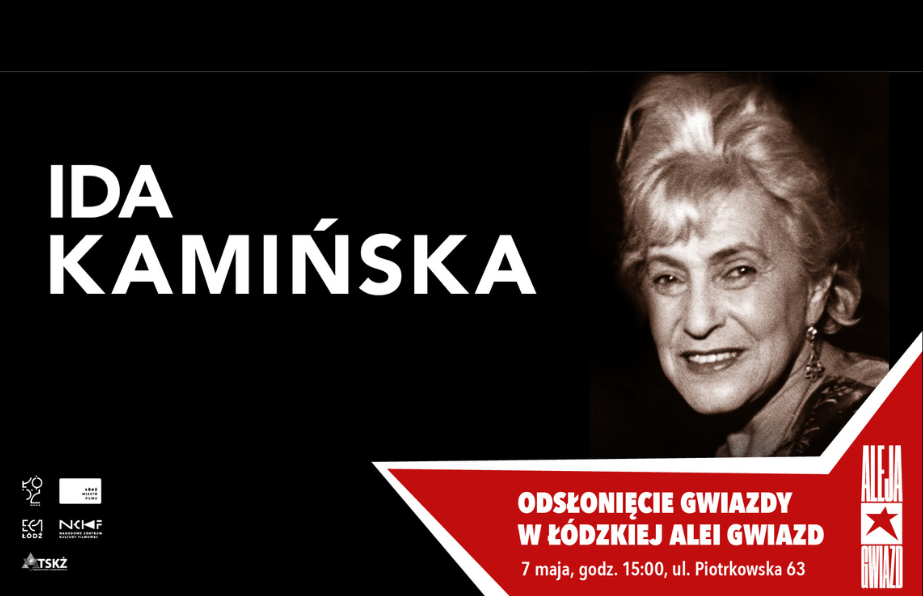On May 7, 2024 on the Łódź Walk of Fame at Piotrkowska Street the star of Ida Kaminska, film actress will be unveiled. Ida Kamińska was the most outstanding, next to her mother, representative of Yiddish theatre, director, director of the Jewish Theatre in Łódź and later in Warsaw, and the only Polish citizen nominated for an Oscar for a leading actress. The originator and founder of the Star is the Social and Cultural Association of Jews in Poland.
Ida Kaminska was born on September 4, 1899, in Odessa, in a theatre hotel. Her parents, Abraham and Ester Rachel Kaminski, lived there during their hosting performances. Ida’s father was a stage director, actor and theatre entrepreneur. Her mother, on the other hand, was an actress, later nicknamed as “the mother of Jewish theatre.” From her earliest years, young Ida helped her parents on the back of theatrical productions. She appeared on stage at the age of six in a play titled Di Muter (The Mother) by Dawid Pinski. Meanwhile, she considered her real theatrical debut to be the role of Isaac in a play entitled Akejdos Jicchok by Abraham Goldfaden. She was 16 at that time. However, she had already made her film debut three years earlier. She played the role of Shayndele in Mirela Efros (directed by Andrzej Marek, 1912) alongside her mother, father and sister Regina.
In 1918, Ida Kaminska married Zygmunt Turkow, an actor and director. The couple later co-founded the Warsaw Jewish Art Theatre. At the theatre they staged plays by Jewish classics such as: Ettinger, Sforim and Ash, but also Molière, Gogol and Hugo. Ida Kaminska appeared on stage (also in Belgium and France), but also directed and translated theatrical plays. She also did not abandon the cinema and starred in the first Jewish film of the interwar period, entitled The Vow (1924), which was a Polish-American production directed by Zygmunt Turkow.
After the breakup of the Warsaw Jewish Art Theater and the separation from her husband, Ida Kaminska founded her own troupe, which from 1937 was based in Warsaw’s Teatr Nowości. -/-
Shortly before the onset World War II, Ida Kaminska appeared in one of the leading roles in the 1939 film titled Homeless (On a hejm – Baal tszuwe) directed by Aleksander Marten. Soon the fate of the film characters became her personal reality: she embarked on a journey around the world to save her family. After the Germans occupied Warsaw, she fled with her daughter named Ruth, her son-in-law Adolf Rosner and her second husband, actor Marian Melman, to Lviv, then Kyrgyzstan, before finally settling in Moscow in 1944. In all these locations, she performed on stage and hosted theatrical performances.
When the war ended, she returned to Poland. In 1948 she became the director of the Jewish Theatre in Lodz, and settled at 22 Stefan Jaracz St. In 1955 she headed the newly established National Jewish Theatre in Warsaw.
Her first post-war film, which proved to be her biggest blockbuster success, was a 1965 Czechoslovakian film entitled The Main Street Shop (Obchod na korze) by Ján Kadár and lmar Klos. The role of Rozália Lautmannova brought Iga Kaminska a special mention at the Cannes Film Festival (1965), a Golden Globe nomination (1967) for best actress in a drama, and the Academy Award nomination (1967) for the best leading actress. At the time, she lost only to Elizabeth Taylor, who received an Oscar statuette for her role in Who’s Afraid of Virginia Woolf? Ida was the first, and so far only, Polish actress nominated for an Oscar. The Main Street Shop, featuring Ida Kamińska, as the leading actress, was awarded the Academy Award for Best Foreign Language Film in 1966. She also delivered an outstanding acting performance in Black Dress (1967), directed by Janusz Majewski, whose archive was recently donated to the collection of the National Film Culture Centre in Łódź.
After the anti-Semitic backlash in 1968, Ida Kaminska and her family emigrated from Poland. Before the end of 1968, traveling through Vienna and Tel Aviv, she arrived in the United States. She settled in New York. She tried to open a Jewish theater there, but without success. In 1970 she starred in a drama entitled The Angel Levine, directed by Ján Kadár. Ida Kaminska died on May 21, 1980 in New York. She was buried at Mount Hebron Cemetery, in the section where many artists of the American Yiddish scene have been laid to rest.
Today, the Jewish Theatre in Warsaw bears the names of Ida Kaminska and her mother Esther Rachel.
The originator and funder of the star on the Walk of Fame is the Social and Cultural Association of Jews in Poland, the oldest secular Jewish organization. Residents of Łódź are already familiar with the TSKZ thanks to such an initiatives as THE DAYS OF REMEMBRANCE – Łódź Celebrations of the International Holocaust Remembrance Day, an annual event which has been co-organized in cooperation with the Stefan Jaracz Theater in Łódź for the past 15 years. Honouring Ida Kaminska with a special plaque in the Walk of Fame is the beginning of the celebration of the 125th anniversary of the actress’s birth, planned by the TSKZ until autumn, which will culminate in a theatrical performance.
On the day of the unveiling of the Star, the organizers and sponsors have also planned a screening of The Main Street Shop, which will be preceded by a interview with Artur Hofman, president of the Social and Cultural Association of Jews in Poland, but also an actor and director who began his career at the Jewish Theatre.


